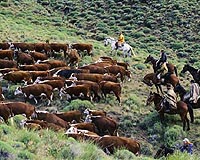 |
Mexico City, Mexico (SPX) Sept 01, 2009 Selection of a crop cultivar is one of the most important management decisions a farmer makes. However, choosing a cultivar for a particular environment, depending on the location or year, is an immense challenge because of unpredictable performance of cultivars across environments. This relationship is known as genotype-by-environment interaction (GE). Despite continued efforts to breed for cultivars with wide adaptability, GE is still a major impediment to reliable identification of superior cultivars for optimal production. Over the past several decades, numerous statistical methods have been developed to facilitate the analysis and understanding of complex GE variability in regional cultivar trials, enhancing researchers ability to correctly identify superior cultivars. However, some of these methods have been overutilized or abused to a point that dubious results and conclusions may have been drawn. Rong-Cai Yang, a scientist with Alberta Agriculture and Rural development and University of Alberta, along with his collaborators Jose Crossa and Juan Burgueno, from International Maize and Wheat Improvement Center (CIMMYT), and Paul Cornelius from the University of Kentucky, has taken the issue to one of these methods. This findings of this study is featured in the September-October 2009 issue of Crop Science, providing a critical evaluation of the biplot analysis of cultivars. Biplot, a scatter plot that simultaneously displays points or scores for genotypes and environments, has been extensively used for studying GE or any two-way data table. Its descriptive and visualization capabilities along with the availability of user-friendly software have enabled plant scientists to examine any two-way data by a click on a computer button. However, according to Yang, the problem is the utility and interpretations of such biplots beyond their functionality and capability. "A biplot is simply a descriptive, graphical tool for a quick view of GE data but it cannot be used for hypothesis testing because there is no uncertainty measure," says Yang, whose research was supported by Alberta Agriculture and Rural Development and the Natural Sciences and Engineering Research Council of Canada. Yang and his co-authors used their own wealth of experiences and expertise with GE analysis to identify and discuss six critical issues arising from the use of biplot analysis. These authors stressed that mere subjective judgment calls from visualization of biplots would not be sufficient. They recommended the use of confidence regions for individual genotype and environment scores in biplots, thereby selecting and recommending cultivars on sound statistical and scientific bases. In particular, they proposed the use of a bootstrap re-sampling strategy for constructing such confidence regions. Research is ongoing to add statistical inference capability to the biplot analysis for sound decision on cultivar selection and recommendation. Share This Article With Planet Earth
Related Links International Maize and Wheat Improvement Center (CIMMYT) Farming Today - Suppliers and Technology
 Argentine farm strike a blow to exports
Argentine farm strike a blow to exportsBuenos Aires (UPI) Aug 28, 2009 A new farm strike looms over Argentina and is poised to deliver another blow to the country's fragile economy and pose new challenges to the presidency of Cristina Fernandez de Kirchner. A previous strike in June damaged the president's parliamentary majority and cut away at her approval ratings. Industry sources said the new strike, set to start at midnight Friday and last a week ... read more |
|
| The content herein, unless otherwise known to be public domain, are Copyright 1995-2009 - SpaceDaily. AFP and UPI Wire Stories are copyright Agence France-Presse and United Press International. ESA Portal Reports are copyright European Space Agency. All NASA sourced material is public domain. Additional copyrights may apply in whole or part to other bona fide parties. Advertising does not imply endorsement,agreement or approval of any opinions, statements or information provided by SpaceDaily on any Web page published or hosted by SpaceDaily. Privacy Statement |